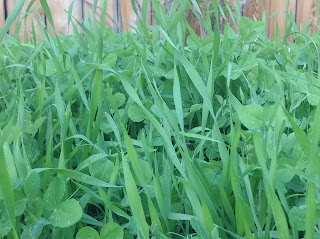 |
| Close Up Cover Crop - Austrian Peas/Winter Rye |
Green manures can be direct seeded in the fall, spring or summer, just be sure to give the cover crop enough time to decompose before planting the next season of vegetables or annuals. Allow at least six weeks or longer to completely break down. If planted in the fall the hardy crops like winter rye and field peas will grow through the winter. Buckwheat and clover winter kill.
Be careful not to let the crop go to seed, this is more of a consideration with spring or summer planted green manures.
 |
| Rake area, spread seeds, cover seeds with soil and water |
Check with your local garden center for seed availability or mail order.

This bed was planted in October with winter rye and field peas. It's okay to mix seeds.
This bed was turned over in late winter and allowed several weeks to break down before planting.
Cover
Crop
|
Sowing
Time
|
Seeding
Rate Per 100 sq. ft.
(10’ x 10’ Garden) |
Does
This Plant Fix Nitrogen?
|
Growth
Rate
|
Primary
Uses/
Comments |
Buckwheat
|
Spring,
Summer |
2
lb
|
No
|
Fast
|
Is easily worked into the soil.
Attracts pollinators and beneficial insects.
Re-seeds prolifically.
DO NOT allow to go to seed. |
Clover
(Sweet) |
Spring,
Summer |
½
lb
|
Yes
|
Medium
|
Grows better in high pH soils than
other clovers.
|
Oats
|
Late
Summer, Early Fall
|
4
lb
|
No
|
Medium
|
Likes well drained soils.
Dies over the winter.
Makes a good choice in areas to be
worked early the following spring.
|
Peas
(Field) |
Spring,
Early Fall |
5
lb
|
Yes
|
Fast
|
Can outcompete many weeds.
|
Radish
(Oilseed) |
Fall
|
1
lb
|
No
|
Fast
|
Is easily worked into the soil.
|
Rye
(Winter) |
Fall
|
4
lb
|
No
|
Fast
|
Easy to grow.
Grows fast.
Can be planted late in the season.
|
Ryegrass
(Annual) |
Late
Summer, Early Fall
|
1
lb
|
No
|
Fast
|
Easy to grow.
|
Wheat
(Winter) |
Late
Summer, Fall
|
2
lb
|
No
|
Fast
|
Needs fertile soil.
Does not like low pH soils.
|
Chart from Wisconsin Horticulture
 |
| Summer planted buckwheat, beautiful plant and attracts beneficial insects! |

No comments:
Post a Comment
Note: Only a member of this blog may post a comment.